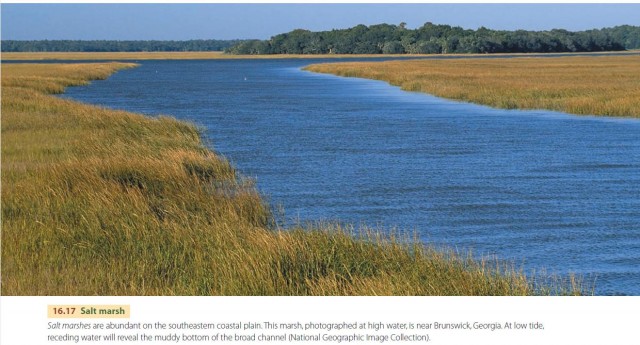The Work of Waves and Tides
Wind, like running water, glacial action, and mass wasting, is an agent that shapes distinctive landforms. Wind can move material directly, picking up fine particles and carrying them from one place to another. Or it can act indirectly, by the action of wind-driven waves. What makes wind and breaking waves different from the other agents is that they can move material against the force of gravity.
Waves are the most important agents that shape coastal landforms. When winds blow over broad expanses of water, they generate waves. Both friction between moving air and the water surface and direct wind pressure on the waves transfer energy from the atmosphere to the water. Most of this energy is used up in the constant churning of mineral particles and water as waves break at the shore. This churning erodes shoreline materials, moving the shoreline landward. Waves and currents can also move sediment along the shoreline for long distances. This activity can build beaches outward as well as form barrier islands just offshore.
Note that throughout this chapter we will use the term shoreline to mean the shifting line of contact between water and land. When we use the word coastline, or simply coast, we're referring to the zone in which coastal processes operate or have a strong influence. The coastline includes the shallow water zone in which waves perform their work, as well as beaches and cliffs shaped by waves, coastal dunes, and bays—bodies of water that are sheltered from strong wave action. Where a river empties into an ocean bay, the bay is called an estuary. In an estuary, fresh and ocean water mix, creating a unique habitat for many plants and animals that is neither fresh water nor ocean.
WAVES
Water waves are a regular rising and falling of the water surface that moves a floating object up and down, forward and back. As shown in Figure 16.6, waves have crests and troughs. Wave height is the vertical distance between trough and crest. Wave length is the horizontal distance from trough to trough or from crest to crest. The wave typically travels in a forward direction as parallel fronts of crests and troughs. The wave period is the time in seconds between successive crests or successive troughs that pass a fixed point.
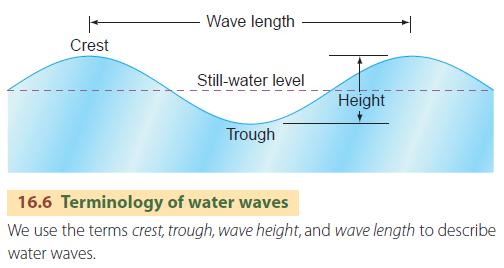
Wind-generated ocean waves are an example of oscillatory waves. In this type of wave, a tiny particle, such as a drop of water or a small floating object, completes one vertical circle, or wave orbit, with the passage of each wave length (Figure 16.7). The circle of motion grows rapidly smaller with depth.
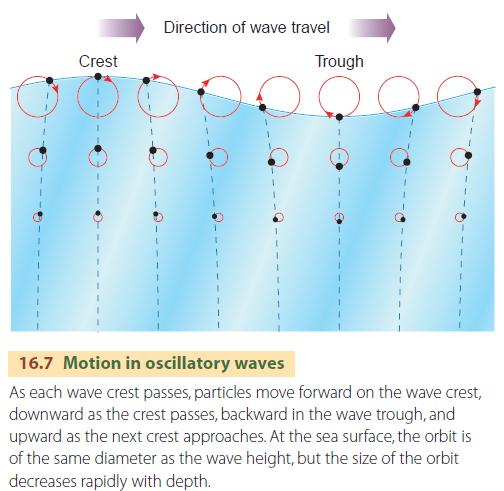
For lake and ocean waves pushed by the wind, particles trace an orbit in which the forward speed of each particle at the crest is slightly greater than the backward speed at the trough. As a result, there is net forward motion of water associated with most lake and ocean wave trains. The amount of motion depends on the size and steepness of the waves, and strong waves are capable of pushing large amounts of water toward the beach. This causes local sea level to rise and generates local currents of water heading back out to sea.
The height of waves is determined by wind speed, wind duration, and fetch—the distance that the wind blows over the water. Table 16.1 shows how these factors are interrelated. Given a sustained wind, average and peak wave heights increase with fetch and duration, until waves are fully developed.

Wave height increases rapidly with increased wind speed. For example, the table shows that if sustained wind speed is doubled from 25 to 50 knots (13–26 m/s, 29–58 mi/hr), average wave height increases by more than fivefold, from 2.7 m (9 ft) to 15 m (48 ft), and peak waves reach 30 m (99 ft). When you coupled these values with the fact that the energy of a wave is proportional to the square of its height, you can appreciate how hurricane winds can generate waves with enormous destructive power.
Waves don't lose much energy as they travel across the deep ocean. But what happens when a wave reaches the shore? As it reaches shallow water, the drag of the bottom slows and steepens the wave. However, the wave top maintains its forward velocity and eventually falls down onto the face of the wave, creating a breaker (Figure 16.8). Tons of foamy turbulent water surge forward in a sheet, riding up the beach slope. This powerful swash moves sand and gravel on the beach landward. Once the force of the swash has been spent against the slope of the beach, the return flow, or backwash, pours down the beach. This “undercurrent” or “undertow” can sweep unwary bathers off their feet and carry them seaward beneath the next oncoming breaker. The backwash carries sand and gravel seaward, completing the wave cycle.

MARINE SCARPS AND CLIFFS
If you've ever visited a beach when waves are high, you've seen how the force of tons of water moving up and down the beach can do enormous amounts of work. If the coastline is made up of weak or soft materials—various kinds of regolith, such as alluvium—the force of the forward-moving water alone easily cuts into the coastline. Here, erosion is rapid, and the shoreline may recede rapidly. Under these conditions, a steep bank, or marine scarp, will form and steadily erode as it is attacked by storm waves.
If a marine cliff lies within reach of the moving water, it will be hit with tremendous force. The surging water carries rock fragments of all sizes that are thrust against the bedrock of the cliff. The impact breaks away new rock fragments and undercuts the cliff at the base.
In this way, the cliff erodes shoreward, maintaining its form as it retreats. But since the marine cliff is made of hard bedrock, retreat is exceedingly slow. The wave erosion produces some unique landforms—caves, stacks, arches, and an abrasion platform.
BEACHES AND LITTORAL DRIFT
Where sand is available to wave action, it accumulates as a thick, wedge-shaped deposit, or beach. Beaches absorb the energy of breaking waves. During periods of storm activity (winter, for example), the beach is cut back, and sand is carried offshore a short distance by the heavy wave action. But the sand is slowly returned to the beach during long periods when waves are weak (summer). In this way, a beach may stay quite stable over the years—but alternate through narrow and wide configurations.
Although most beaches are made from particles of fine to coarse quartz sand, some beaches are built from rounded pebbles or cobbles. Still others are formed from fragments of volcanic rock or even shells.
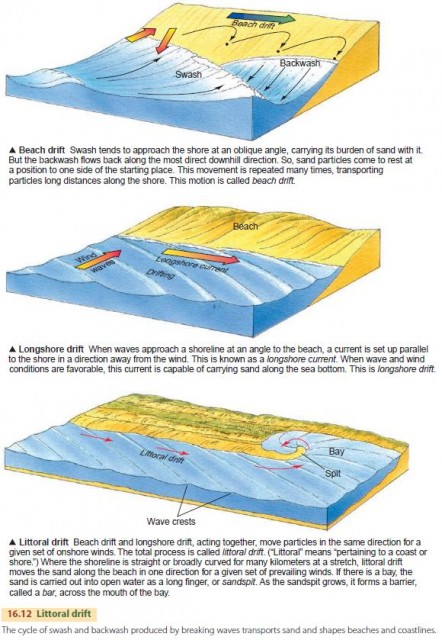
Breaking waves also produce currents that move sediment along the shoreline (Figure 16.12). When waves attack at an angle, the swash and backwash move sand down the beach, away from the wind direction, as beach drift. Wave water piling up in the breaker zone sets up a longshore current just offshore from the breakers that moves sediment in the same direction. The two flows constitute littoral drift. Where the beach is straight, littoral drift forms sand bars and sandspits. Where the shoreline includes resistant headlands, littoral drift builds pocket beaches in bay heads from sediments eroded from the headlands (Figure 16.14).

When sand arrives at a particular section of the beach more rapidly than it is carried away, the beach is widened and built oceanward. This change is called progradation (building out). When sand leaves a section of beach more rapidly than it is brought in, the beach is narrowed and the shoreline moves landward. This change is called retrogradation (cutting back).
Along stretches of shoreline affected by retrogradation, the beach may be seriously depleted or even entirely disappear, destroying valuable shore property. In some circumstances, we can take steps to encourage progradation and build a broad, protective beach. We can do this by installing groins at close intervals along the beach. A groin is simply a wall or an embankment usually built at right angles to the shoreline and made from large rock masses, concrete, or wooden pilings. Groins trap sediment moving along the shore as littoral drift (Figure 16.15).
In some cases, beach sand comes from sediment that is delivered to the coast by a river. That means that dams constructed far upstream on the river can cause retrogradation on a long stretch of shoreline by drastically reducing the sediment load of the river.
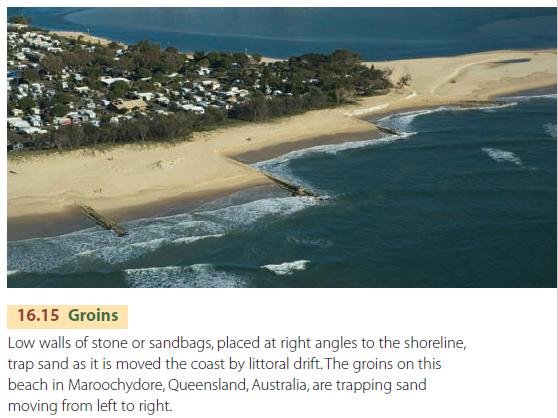
TIDAL CURRENTS
Most marine coastlines are influenced by the ocean tide—the rhythmic rise and fall of sea level under the influence of changing attractive forces of the Moon and Sun on the rotating Earth. If the tides are large, the changing water level and the tidal currents play an important role in shaping coastal landforms. Figure 16.16 shows the rise and fall of water level over a day at Boston Harbor in a tide curve.
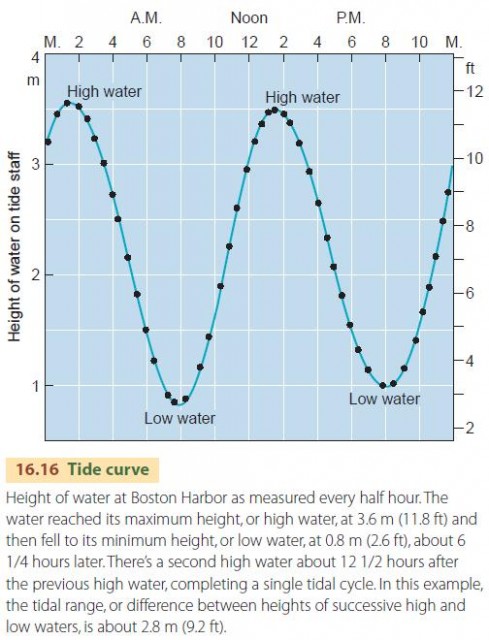
In bays and estuaries, the changing tide sets up tidal currents. When the tide begins to fall, an ebb current sets in. This flow ceases about the time when the tide is at its lowest point. As the tide begins to rise, a landward current, the flood current, begins to flow.
Ebb and flood currents perform several important functions along a shoreline. First, the currents that flow in and out of bays through narrow inlets are very swift—scouring the inlet. This keeps the inlet open, despite littoral drifting that tends to close the inlet with sand.
Second, tidal currents hold large amounts of fine silt and clay, suspended in the water. This fine sediment comes from streams that enter the bays or from mud that has been agitated up from the bottom by storm waves. The sediment settles to the floors of the bays and estuaries, and builds up in layers, gradually filling the bays. It contains a lot of organic matter.
In time, tidal sediments fill the bays and produce mud flats, which are barren expanses of silt and clay. They are exposed at low tide but covered at high tide. Next, salt-tolerant plants start to grow on the mud flat. The plant stems trap more sediment, and the flat builds up, becoming a salt marsh (Figure 16.17). A thick layer of peat eventually forms at the salt marsh surface.
